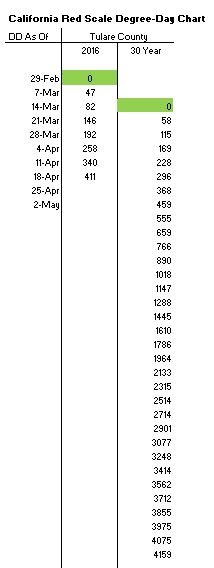Similar to last year, degree days are accumulating rapidly this spring, well in advance of the 30 year average. This has an impact on the development of all insect pests. To see a comparison of current dd and 30 year average dd for California red scale, go to the UC KAC Entomology degree days for California red scale and click on any one of the four San Joaquin Valley regions. Below we show a Tulare County site as an example. You will see that the biofix was earlier than normal (early to mid March) and the current degree days for that insect are >100 dd farther along than the 30 year average. This is the fifth year in a row (2012-2016) we have had this situation of rapid degree day accumulations, which accelerates the development of the insect.
In addition, I have also heard that in the southern end of the San Joaquin Valley, the crawlers were emerging before the 550 degree day mark, which means that, for the second year in a row, we did not have cold enough temperatures to cause California red scale to diapause. This makes timing insecticide treatments extremely difficult because the scales are not developing uniformly and the window of crawler activity is very wide. The extra degree days allows extra generations of California red scale to develop. Most of the available red scale insecticides are not persistent enough to control more than one or two generations. Starting last year, some growers began treating more than once per year for red scale.
Its hard to say if this pattern will continue, but cooler winters and springs would help immensely with California red scale control.
